The Intel Haswell-E CPU Review: Core i7-5960X, i7-5930K and i7-5820K Tested
by Ian Cutress on August 29, 2014 12:00 PM ESTGaming Benchmarks
One of the important things to test in our gaming benchmarks this time around is the effect of the Core i7-5820K having 28 PCIe 3.0 lanes rather than the normal 40. This means that the CPU is limited to x16/x8 operation in SLI, rather than x16/x16.
F1 2013
First up is F1 2013 by Codemasters. I am a big Formula 1 fan in my spare time, and nothing makes me happier than carving up the field in a Caterham, waving to the Red Bulls as I drive by (because I play on easy and take shortcuts). F1 2013 uses the EGO Engine, and like other Codemasters games ends up being very playable on old hardware quite easily. In order to beef up the benchmark a bit, we devised the following scenario for the benchmark mode: one lap of Spa-Francorchamps in the heavy wet, the benchmark follows Jenson Button in the McLaren who starts on the grid in 22nd place, with the field made up of 11 Williams cars, 5 Marussia and 5 Caterham in that order. This puts emphasis on the CPU to handle the AI in the wet, and allows for a good amount of overtaking during the automated benchmark. We test at 1920x1080 on Ultra graphical settings.
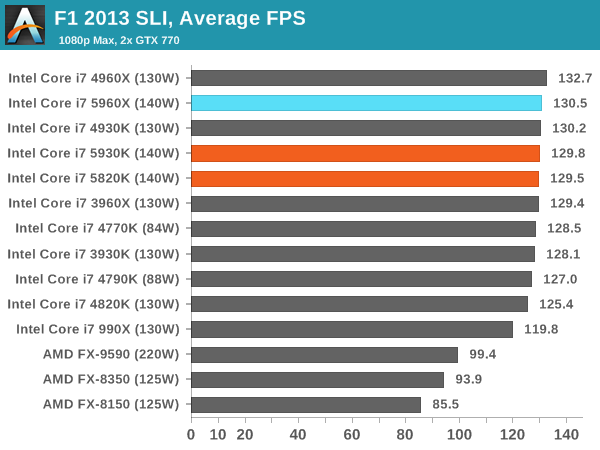
Nothing here really shows any advantage of Haswell-E over Ivy Bridge-E, although the 10% gaps to the 990X for minimum frame rates offer some perspective.
Bioshock Infinite
Bioshock Infinite was Zero Punctuation’s Game of the Year for 2013, uses the Unreal Engine 3, and is designed to scale with both cores and graphical prowess. We test the benchmark using the Adrenaline benchmark tool and the Xtreme (1920x1080, Maximum) performance setting, noting down the average frame rates and the minimum frame rates.
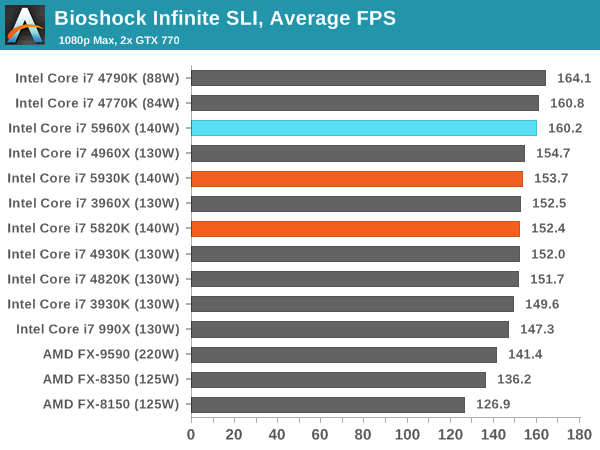
Bioshock Infinite likes a mixture of cores and frequency, especially when it comes to SLI.
Tomb Raider
The next benchmark in our test is Tomb Raider. Tomb Raider is an AMD optimized game, lauded for its use of TressFX creating dynamic hair to increase the immersion in game. Tomb Raider uses a modified version of the Crystal Engine, and enjoys raw horsepower. We test the benchmark using the Adrenaline benchmark tool and the Xtreme (1920x1080, Maximum) performance setting, noting down the average frame rates and the minimum frame rates.
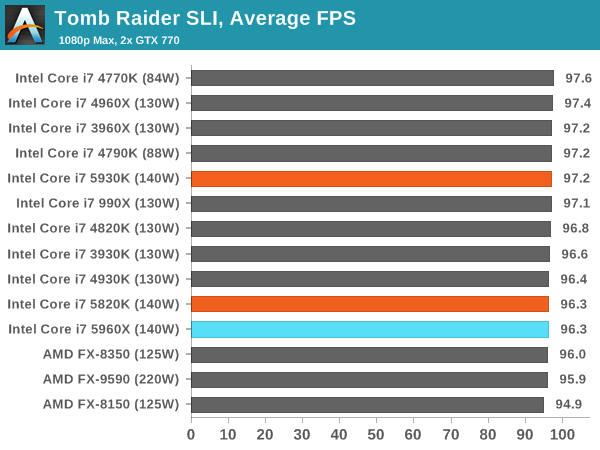
Tomb Raider is blissfully CPU agnostic it would seem.
Sleeping Dogs
Sleeping Dogs is a benchmarking wet dream – a highly complex benchmark that can bring the toughest setup and high resolutions down into single figures. Having an extreme SSAO setting can do that, but at the right settings Sleeping Dogs is highly playable and enjoyable. We run the basic benchmark program laid out in the Adrenaline benchmark tool, and the Xtreme (1920x1080, Maximum) performance setting, noting down the average frame rates and the minimum frame rates.
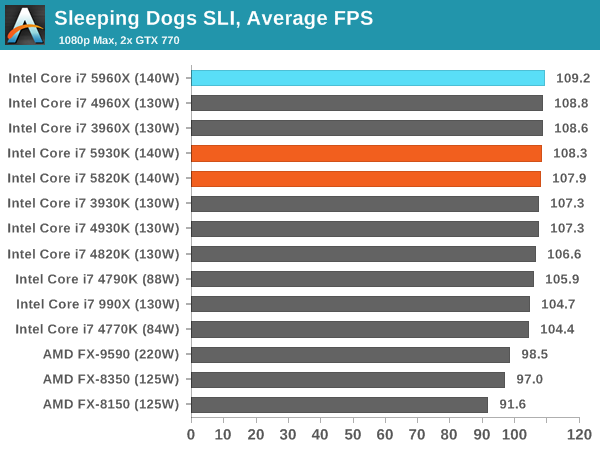
The biggest graph of CPU performance change is the minimum frame rate while in SLI - the 5960X reaches 67.4 FPS minimum, with only the xx60X CPUs of each generation moving above 60 FPS. That being said, all the Intel CPUs in our test are above 55 FPS, though it would seem that the 60X processors have some more room.
Battlefield 4
The EA/DICE series that has taken countless hours of my life away is back for another iteration, using the Frostbite 3 engine. AMD is also piling its resources into BF4 with the new Mantle API for developers, designed to cut the time required for the CPU to dispatch commands to the graphical sub-system. For our test we use the in-game benchmarking tools and record the frame time for the first ~70 seconds of the Tashgar single player mission, which is an on-rails generation of and rendering of objects and textures. We test at 1920x1080 at Ultra settings.
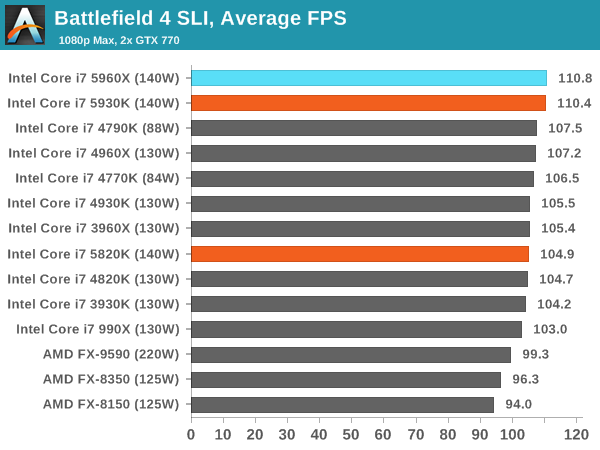
Battlefield 4 is the only benchmark where we see the 5820K with its 28 PCIe lanes down by any reasonable margin against the other two 5xxx processors, and even then this is around 5% when in SLI. Not many users will notice the difference between 105 FPS and 110 FPS, and minimum frame rates are still 75 FPS+ on all Intel processors.















203 Comments
View All Comments
oranos - Sunday, August 31, 2014 - link
Just like with anything in life, there are some people who will pay a premium to have the best of the best. This is exactly that.oranos - Sunday, August 31, 2014 - link
As a matter of fact, for the next generation (nvidia 9xx series and amd xxx) in quad sli/xfire setups, this chip will allow more bandwidth through the PCI-E lanes. So for the top 1% of setups this chip does matter.mlambert890 - Monday, September 1, 2014 - link
no it wont. my p7x79ws with 3960x and tri sli titan has 40 native pcie 3 lanes. sb-e has 40 lanes and pcie 3 support. advanced x79 boards with current bios fully support.this is a non upgrade honestly (x99) vs a high end x79. all you really get is usb3 and sata 6Gb/s native vs third party integrated (BFD), and the mixed bag that is ddr4
Fedor - Monday, September 1, 2014 - link
Very strangely, tomshardware has the 5820 beating out the 5930 and 5960 in gaming benchmarks. The test platforms here and there are very different, but for a start it would be great if you guys could also show us some results with a single GPU for the 5820 and 5930.TiGr1982 - Tuesday, September 2, 2014 - link
IMHO, tomshardware messed up something here - there is no physical reason why 5820 can beat 5930, because they have the same core count and cache structure, but 5930 has higher frequencies and 40 PCIe lanes vs 28 lanes of 5820.Fedor - Wednesday, September 3, 2014 - link
Yup, I'm leaning towards the same conclusion. It's a shame that most reviews do not cover anything but the highest-end chip, but between anandtech, tomshardware, 3dguru and another review I found in Belgian (the graphs were self-explanatory at least ;) only tomshardware has that anomaly, so I'm inclined to agree.Bombreezey - Monday, September 1, 2014 - link
These cpu's would be more beneficial to higher resolution gaming. I love how people are trying to compare this new cpu's to the i5-2500k. There is nothing wrong with the 2500k when gaming at 1080p but when the time comes when people start witching over to 4k gaming when it becomes more affordable your 2500k is gonna struggle big time. Like people have said earlier, there is more to computing than gaming. These cpu's will be vastly faster at video converting/rendering, and other cpu intensive applications when compared to older series of intel cpu's. On another note I see people are complaining about heat because of the high tdp... when there are more cores its gonna need more power......soooooo get a water cooler and problem solve :). At least the tdp isnt 220watts like amd 8 core cpu. So 150watts is pretty fair for a intel 8 core cpu that straight up murders a AMD 8 CORE CPU.untoreh - Friday, September 12, 2014 - link
amd octa core costs 1/4 of the intel octa core, if not 1/5.soldier45 - Monday, September 1, 2014 - link
Was thinking of moving from my 2600k at 4.8 to the 5930k but really not worth the $ for a 20% boost in certain apps and little to no improvement in gaming.ryanbrod - Monday, September 1, 2014 - link
Why is it that every review of the haswell-e chipsets doesn't even make an attempt to saturate more then 16 pcie lanes... The whole point of the haswell-e chips in my opinion is the extra PCIe Lanes for tri and quad sli/crossfire set ups. dual gtx 770s is a joke of a review if you ask me. Put in at least 3 of them or dont do a gaming review at all because its going to be less then 2% difference in performance from regular i7s.